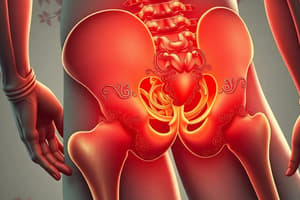Podcast
Questions and Answers
What is the primary factor contributing to musculotendinous factors in painful hip syndromes?
What is the primary factor contributing to musculotendinous factors in painful hip syndromes?
- Excessive strain while the muscle is contracting (correct)
- Inadequate time for injured tissue to heal
- Weak gluteus medius and gluteus minimus muscles
- Dominance of the tensor fasciae latae and rectus femoris
Which of the following is NOT a type of bursitis associated with painful hip syndromes?
Which of the following is NOT a type of bursitis associated with painful hip syndromes?
- Ischiogluteal bursitis
- Psoas bursitis
- Iliopsoas bursitis (correct)
- Trochanteric bursitis
What is the primary cause of tears in the acetabular labrum in Femoroacetabular Impingement (FAI)?
What is the primary cause of tears in the acetabular labrum in Femoroacetabular Impingement (FAI)?
- Capsular laxity
- Acetabular labral impingement
- Trauma, acetabular labral impingement, capsular laxity, dysplasia, and degeneration (correct)
- Dysplasia and degeneration
Which muscle is associated with dominance over the gluteus maximus in some painful hip syndromes?
Which muscle is associated with dominance over the gluteus maximus in some painful hip syndromes?
What is the typical presentation of a posterior tear in Femoroacetabular Impingement (FAI)?
What is the typical presentation of a posterior tear in Femoroacetabular Impingement (FAI)?
What is the underlying characteristic of the gluteus medius and gluteus minimus muscles in some painful hip syndromes?
What is the underlying characteristic of the gluteus medius and gluteus minimus muscles in some painful hip syndromes?
Flashcards are hidden until you start studying




